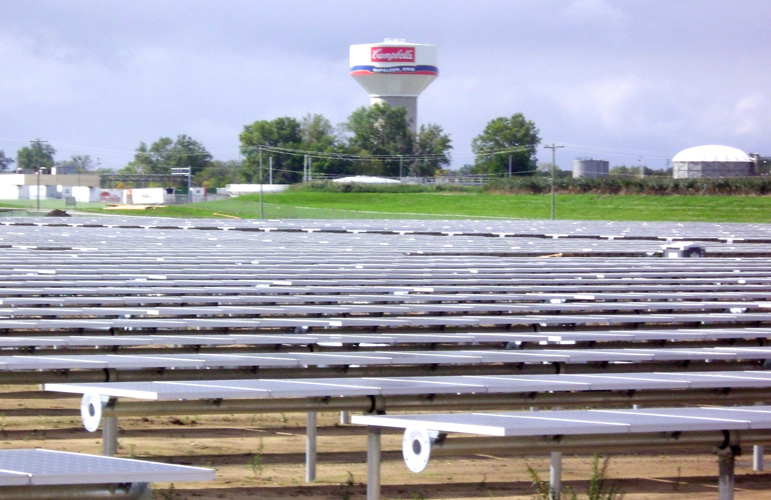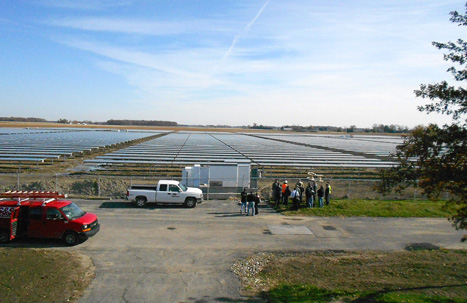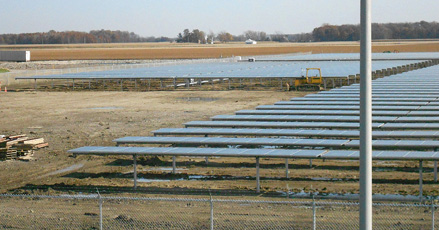Back Issues
Solar project proves to be MmmMmm Good for Campbell's SoupThe Campbell Soup Company has taken a big spoonful of PV power, with the installation of a 9.8 MW solar power system at its Napoleon, Ohio, facility, said to be the largest food production plant in the world. By
Vicky Boyd
Since then, the Camden, New Jersey-based firm has grown to become world renowned for its soups as well as V8 beverages, Pepperidge Farm cookies and baked goods, SpaghettiOs, Prego Italian sauces, and Pace salsa, to name a few of its food products. The Campbell Soup Co. recently became known for another product—large-scale solar-generated electricity. When a 9.8 megawatt photovoltaic project came online at Campbell's Napoleon, Ohio, plant this past December, it marked the largest solar inside-the-fence project in the United States. The single-axis tracking system will supply about 15 percent of the plant's annual electricity needs. Spurred partly by shareholders and large customers such as Walmart and partly out of social responsibility, company leaders implemented a sustainability initiative about five years ago, says Bob Shober, the company's vice president of infrastructure, engineering, and environmental programs. As part of that initiative, leaders set lofty goals of reducing greenhouse gas emissions by 50 percent per unit of production by 2020. The sustainability initiative also means becoming more energy efficient and converting 40 percent of the company's electricity use to renewable sources, he says. The recently completed Napoleon PV project, as well as a 250 kilowatt system in Puurs, Belgium; a 100 kW system in Paris, Texas; and a 2.3 MW system in the works for Sacramento, California, will supply about six percent of the company's electricity demand. "This is a start—a good start," Shober says. Campbell's Napoleon plant, located about 40 miles southwest of Toledo, is billed as the world's largest food processing plant with 55 acres under one roof. It produces mainly soup and juice products. In 2008, company leaders began exploring ways to meet their sustainability goals through renewable energy. Among the options were developing a project themselves, buying so-called green electricity, or entering into a Power Purchase Agreement (PPA) with a renewable energy developer, Shober says. Developing the project themselves didn't meet specific company financial thresholds, he says. "We have completed many energy efficiency projects that provide the company an excellent return on our investment," Shober says. "While the Napoleon solar panel project has a solid financial return, it doesn't meet our internal hurdle rate for savings projects." If the Campbell Company went on the open market to purchase so-called green electricity, it wouldn't have been able to lock in a favorable rate for 20 years as it did with the eventual PPA. "We could go on the market and offset 40 percent of our electricity today by buying green power, but this didn't feel right," he says. "With the purchase of green electricity, you're paying an additional cost and have nothing to show other than a certificate that says you are buying green electricity.
When Campbell's officials decided on a PPA, they sought a partner with experience in developing large alternative energy projects and securing the required financing. New York-based BNB Renewable Energy Holdings LLC and Atlanta-based Enfinity America Corp. acted as co-developers of the project. "They had a track record of several large, successful projects that helped us decide to go with them," Shober says of the BNB-Enfinity team. Initially, Campbell and BNB Renewable Energy looked at wind energy for the site adjacent to the plant. "The current system of 60 acres of solar panels would have been the equivalent of four wind turbines," Shober says. "Because it was going to take about two years to get through the permitting process for wind, we switched gears and went with the solar." At about the same time, the Ohio Senate passed Senate Bill 221, which helped expedite permitting for PV projects, says Matthew Baird, a principle and founder of BNB Renewable Energy Holdings. The 2008 legislation was designed to encourage development of alternative, renewable and energy efficiency activities in the state. Among the key provisions are an alternative energy portfolio standard, energy efficiency standards, solar-ready schools, and greenhouse gas emission reporting requirements. Baird says they went with San Jose, California-based SunPower to engineer and build the PV system because it has some of the highest output, lowest cost systems of any company on the market. SunPower's reputation also aids in financing projects that involve its panels, he says. "It's very important to work with a company that has warranties and has enough of a history," Baird says. The Napoleon project was one of the first installations of SunPower's new Oasis power plant in the United States, he says. It comprises the SunPower T0 Tracker and about 24,000 SunPower 425 Solar Panels. "What they've done is pre-engineered the system—a 'megawatt in a box,'" Baird says. "All of the wire runs, the racking systems, the inverter locations, everything has been pre-engineered so they're like building blocks. And they're manufactured in these units." This equates to a lower price for the same high performance while making field installation more efficient, he says. It also simplifies financing. "Once the financing entities know how one system performs, and if they know it can be comparable, it's very easy for them to get behind the next system," Baird says. "Uniquely engineered systems require a lot more field engineering review and involve more risk."
|











